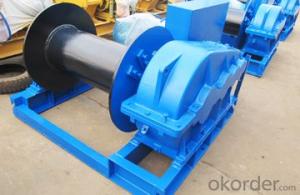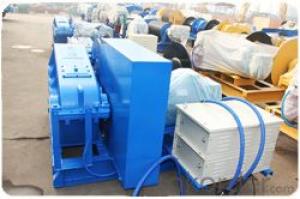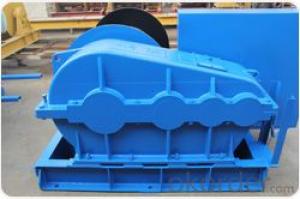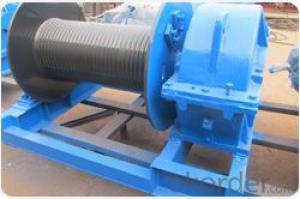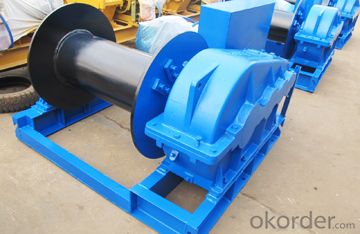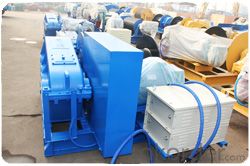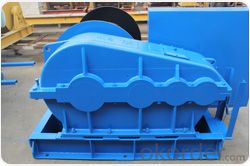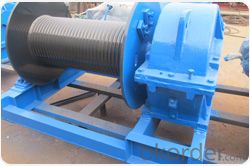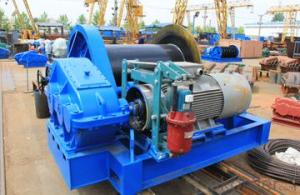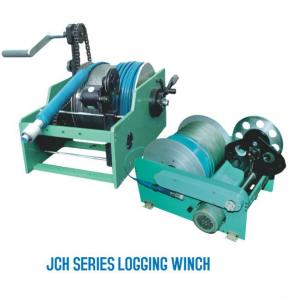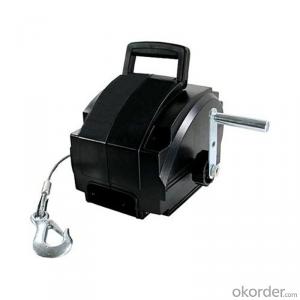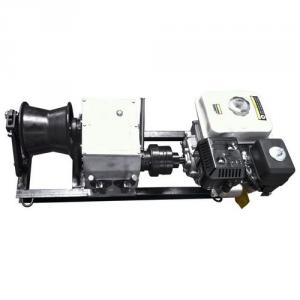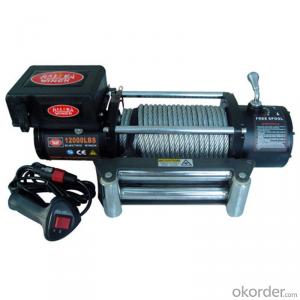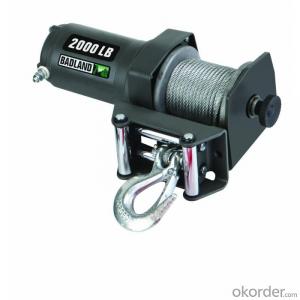Low Speed Electric Winch
- Loading Port:
- Shanghai
- Payment Terms:
- TT OR LC
- Min Order Qty:
- 1 unit
- Supply Capability:
- 30 unit/month
OKorder Service Pledge
OKorder Financial Service
You Might Also Like
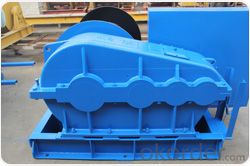
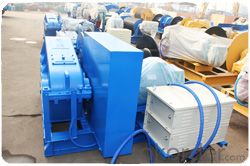
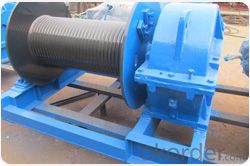
This series is slow speed electric motor driven gear winch; It is mainly used for hoisting, drag-and-drop, loading cargos, such as all kinds of large concrete construction, steel constructions installation and disassembly; The winches are applied to construction company, mine, factory and other installation engineering projects company;
Technical Data:
Basic Parameters | Rated Load | Average Speed | Capacity of Rope | Rope Diameter | Motor Power | Overall Dimension | Total Weight |
Model | KN | m/min | m |
| KW | mm | kg |
JM1 | 10 | 15 | 100 | 9.3 | 3 | 620×701×417 | 270 |
JM1.6 | 16 | 16 | 150 | 12.5 | 5.5 | 945×996×570 | 500 |
JM2 | 20 | 16 | 150 | 13 | 7.5 | 945×996×570 | 550 |
JM3.2 | 32 | 9.5 | 150 | 15.5 | 7.5 | 1430×1160×910 | 1100 |
JM3.2B | 32 | 12 | 195 | 15.5 | 7.5 | 1082×1014×610 | 536 |
JM5 | 50 | 10 | 270 | 21.5 | 11 | 1235×1230×805 | 1560 |
JM5B | 50 | 9.5 | 200 | 21.5 | 11 | 1620×1260×945 | 1800 |
JM5C | 50 | 9.5 | 350 | 21.5 | 11 | 1235×1230×805 | 1800 |
JM5D | 50 | 15 | 350 | 21.5 | 15 | 1235×1230×805 | 1850 |
JM5E | 50 | 20 | 350 | 21.5 | 22 | 1235×1230×805 | 2000 |
JM6 | 60 | 9.5 | 270 | 24 | 15 | 1235×1509×805 | 1800 |
JM8 | 80 | 8 | 250 | 26 | 15 | 2090×1475×956 | 2900 |
JM8B | 80 | 9.5 | 350 | 26 | 15 | 1075×1598×985 | 2650 |
JM10 | 100 | 8 | 170 | 30 | 22 | 2090*1475*956 | 3000 |
JM10B | 100 | 9.5 | 250 | 21.5 | 22 | 1705*1598*985 | 3500 |
JM12.5 | 125 | 8 | 300 | 34 | 30 | 2880*2200*1550 | 5000 |
JM13.5 | 135 | 8 | 290 | 28 | 22 | 2990*2362*1650 | 6500 |
JM16 | 160 | 10 | 500 | 37 | 37 | 3750*2400*1850 | 8800 |
JM20 | 200 | 10 | 600 | 43 | 45 | 3950*2560*1950 | 9900 |
JM25 | 250 | 9 | 700 | 48 | 55 | 4350*2800*2030 | 13500 |
JM32 | 320 | 9 | 700 | 56 | 75 | 4500*2850*2100 | 14800 |
JM50 | 500 | 9 | 800 | 65 | 90 | 4930*3050*2250 | 19500 |
JM65 | 650 | 10.5 | 3600 | 64 | 160 | 5900*4680*3200 | 46000 |
- Q: Is it possible to utilize a building hoist for the purpose of lifting small tools and equipment?
- <p>Yes, a building hoist can be used for lifting small tools and equipment, provided it is within the hoist's weight capacity. It's important to ensure that the items are securely fastened to prevent any accidents during lifting. Always follow the manufacturer's guidelines and safety regulations when using a building hoist for any lifting tasks.</p>
- Q: This question asks if a building hoist is capable of lifting heavy objects.
- <p>Yes, a building hoist is specifically designed to lift large objects. It is a type of crane used in construction to move heavy materials and equipment to different levels of a building under construction. Building hoists can handle a significant weight, but the exact capacity depends on the specific model and its design specifications. They are essential for efficient construction processes, ensuring the safe and effective transportation of materials within the construction site.</p>
- Q: Why is the construction elevator not up to the roof
- The free end of the construction of the lift height is only 7.5 meters high, general construction elevator drive now is the case, so the hoisting cage height and drive around 4.5 meters high, the other national standard construction elevator ceiling limit moves, drive above about 1.8 meters away from the top of the rails. So it's the free end of the construction elevator that can't satisfy the roof.
- Q: This question asks for guidance on selecting an appropriate building hoist for specific requirements.
- <p>Choosing a suitable building hoist involves several considerations. First, assess the load capacity needed based on the weight of materials to be lifted. Consider the hoist's lifting height to ensure it covers the building's full height. Evaluate the frequency of use and the speed required for efficient material movement. Safety features are crucial; look for hoists with certifications and safety mechanisms like overload protection. Check the hoist's durability and maintenance requirements. Finally, consider the cost, including purchase price, operation, and maintenance expenses. Consulting with hoist manufacturers or rental companies can provide personalized advice tailored to your project's specific needs.</p>
- Q: Is it possible to replace a building hoist with an electric winch for the purpose of lifting materials or individuals?
- <p>While theoretically possible, using an electric winch instead of a building hoist for lifting materials or people is not recommended due to safety concerns and differences in design. Electric winches are typically designed for pulling or towing loads and may not have the necessary safety features, load capacity, or stability required for lifting operations in a construction setting. Building hoists are specifically engineered to lift heavy materials and personnel safely in vertical shafts or on the facade of a building. They are equipped with safety devices and are regulated for construction use, making them the appropriate choice for such tasks.</p>
- Q: How much cable does the construction elevator 44KVA need?
- 44 kva should choose 16 + 2 * 3 * 6 square cable, 16 of the 30 ℃ safe carrying capacity is 78 a cable Current I = P/U / 1.732 = 44000/380/1.732 is approximately 67A The construction elevator will not only carry the engineering materials but also the higher frequency, the load calculation will be calculated according to the continuous working system. The cable should be used for the YGTZ special cable.
- Q: This question asks for methods to prevent leakage in hydraulic cylinders used in building hoists.
- <p>To prevent hydraulic cylinder leaks in a building hoist, follow these steps: Regularly inspect and maintain the hydraulic system to ensure all seals and gaskets are in good condition. Replace any worn or damaged components promptly. Ensure the hydraulic oil is clean and at the correct level to avoid air bubbles or cavitation which can cause leaks. Check the cylinder rods for scratches or damage and polish or replace them if necessary. Maintain the correct operating pressure and avoid overloading the hoist. Regularly lubricate moving parts to reduce friction and wear. Implement a routine maintenance schedule to catch and address potential issues before they lead to leaks.</p>
- Q: How is the construction elevator installed
- Construction elevator installation 1) the location of the elevator depends on the condition of the site and the equipment, so as far as possible, stay away from the overhead line and keep the safe distance specified. When the elevator is running, there is a lot of danger and should be avoided. 2) the order of installation is: 3) place the chassis on the base and the base pre-buried bolt, and the platform is placed on the chassis, and the basket is placed in the middle of the chassis. 4) to install the standard section, each installation of two standard sections (usually less than 8m) to be temporarily fixed. The wire rope shall be used for the use of the temporary cable, and the joints and supporting points shall be bolted and not tied with the lead wire. 5) the installation should alternate between the two columns. Node bolt specification must according to the aperture matching, not packing, found that the aperture position at the time, can not arbitrarily expanding, more can't to lead wire bundle, instead to avoid loose node deformation. 6) when installing the standard section, pay attention to the vertical degree of the guide, and the line of the guide line should not appear in the line of folding and too big clearance to prevent the collision from running. 7) when construction site conditions permit, it can be assembled on the ground and then hoisted on the whole to reduce the height of the work. Due to the design of the frame, the stress condition of the construction is only considered, so before the whole moving up, the counter can be temporarily strengthened to enhance the bending capacity of the nodes.
- Q: Is it possible to utilize building hoists for the transportation of materials and equipment within construction sites?
- <p>Yes, building hoists are commonly used in construction sites to move materials and equipment. They are designed to lift and lower heavy loads vertically, making them ideal for transporting construction materials, tools, and equipment between different floors or levels of a building under construction. This equipment significantly enhances efficiency and safety on construction sites by reducing manual labor and the risk of accidents associated with manual handling of heavy items.</p>
- Q: What is the meaning of double straps in the construction elevator?
- One component of the elevator's drag system is the weight of the car. The other side of the car is connected to the top of the car by dragging a wire rope. It can be used for the energy saving of the elevator towing system, because the elevator load optimization is calculated by the theory calculation. The elevator should be calculated before the weight is weighed: the calculation principle is that the weight is equal to the weight of the car and half the load.
Send your message to us
Low Speed Electric Winch
- Loading Port:
- Shanghai
- Payment Terms:
- TT OR LC
- Min Order Qty:
- 1 unit
- Supply Capability:
- 30 unit/month
OKorder Service Pledge
OKorder Financial Service
Similar products
Hot products
Hot Searches
Related keywords
